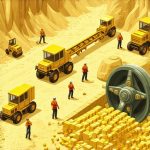Unveiling the Future: An Expert Analysis of Gold Demand Trends in 2025
As we venture into 2025, the dynamics of gold demand are poised to reflect a confluence of macroeconomic factors, geopolitical tensions, and evolving investor sentiment. For seasoned investors and financial strategists, understanding these intricate demand patterns is crucial to craft resilient portfolios and capitalize on emerging market opportunities. This article synthesizes the latest insights, drawing from authoritative sources and market analysis to illuminate the sophisticated landscape of gold investment in 2025.
Deciphering the Complexities of Gold Supply and Demand Cycles
Gold markets operate within intricate supply-demand cycles, driven by central bank policies, jewelry industry trends, and investment flows. According to a comprehensive market analysis report, 2025 may witness heightened demand from central banks, as countries diversify reserves amidst inflationary pressures. Meanwhile, jewelry consumption patterns are evolving, with emerging markets accounting for a significant portion of demand, influenced by demographic shifts and cultural preferences.
Why the Role of Central Bank Purchases Will Be Pivotal in 2025
Central banks are increasingly viewed as pivotal agents influencing gold prices, especially given their strategic accumulation during periods of monetary uncertainty. Recent data indicates that central banks are expected to continue increasing gold reserves in 2025, as detailed in the central bank purchase report. This trend underscores gold’s role as a safe-haven asset and a hedge against fiat currency devaluation, which remains a core consideration for institutional investors.
What are the implications of rising central bank gold reserves for retail investors and portfolio diversification?
Understanding the macroeconomic implications of central bank accumulation can inform strategic asset allocation. For retail investors, integrating gold via ETFs or physical holdings can serve as a hedge against geopolitical risks and currency fluctuations, especially as supply constraints and demand growth tighten the market.
How Will Evolving Jewelry and Industrial Demand Impact Gold Prices?
Beyond investment flows, the jewelry industry’s demand in 2025 is expected to be influenced by technological innovations and shifts in consumer preferences. Additionally, industrial applications, such as electronics and renewable energy sectors, are projected to contribute to steady demand growth. These factors add layers of complexity to forecast models, emphasizing the importance of nuanced market analysis for investors targeting long-term wealth preservation.
Expert Strategies for Navigating the 2025 Gold Market
Adopting a diversified approach—combining physical gold, ETFs, and mining stocks—can optimize risk-adjusted returns in the volatile landscape of 2025. For detailed guidance on structuring resilient portfolios, refer to our comprehensive gold investment strategies. Moreover, staying attuned to market analysis reports will enable investors to anticipate price movements and capitalize on emerging opportunities.
Conclusion
As 2025 unfolds, the intricate interplay of macroeconomic policies, demand from emerging markets, and technological advancements will shape the gold market’s trajectory. For investors seeking to maximize wealth growth and preserve capital, an expert understanding of these trends is indispensable. Engage with authoritative insights and consider developing a strategic gold investment plan tailored to the evolving landscape.
Unraveling the Impact of Geopolitical Shifts on Gold Demand in 2025
As global geopolitical tensions persist, the demand for gold as a safe-haven asset is expected to escalate. Countries involved in trade disputes or conflicts often increase their gold reserves to secure economic stability, which directly influences market prices. The increasing geopolitical volatility has led to a surge in central bank gold acquisitions, emphasizing the importance of monitoring international developments. For investors seeking to adapt, understanding the nuanced relationship between geopolitical events and gold demand is crucial, especially considering the predicted surge in demand from emerging markets and strategic reserve allocations.
How Will Monetary Policy Adjustments Shape Gold Investment Strategies?
Monetary policy decisions, particularly interest rate adjustments by major central banks, significantly impact gold prices. Lower interest rates tend to weaken fiat currencies, making gold an attractive hedge and investment. Conversely, rate hikes can suppress gold’s appeal temporarily but may signal economic shifts that influence long-term trends. Analyzing the policies outlined by institutions like the Federal Reserve or European Central Bank offers valuable insights into potential price movements. For comprehensive planning, investors should consider integrating gold into diversified portfolios, leveraging insights from market analysis reports for optimal timing and asset allocation.
Are there emerging gold investment vehicles that could redefine portfolio diversification in 2025?
Innovative investment options, such as blockchain-backed gold tokens or digital gold platforms, are gaining traction. These vehicles offer liquidity and transparency advantages over traditional physical gold and ETFs. Experts argue that exploring these emerging assets can provide enhanced flexibility and reduce storage concerns. As the industry evolves, staying informed about such innovations is essential for strategic diversification. For detailed insights, investors should explore resources like gold ETFs and mutual funds guide to understand the best ways to incorporate these assets into their portfolios.
The Role of Technological Advancements in Gold Mining and Refining
Technological innovations in mining and refining processes are poised to influence the supply side of gold in 2025. Automation, AI-driven exploration, and environmentally sustainable extraction methods are reducing costs and increasing efficiency. These advancements can lead to more stable supply levels, impacting prices and investment strategies. Moreover, the rise of sustainable mining practices aligns with ethical investing principles, attracting a broader investor base. For investors, understanding how these technological trends impact supply dynamics is pivotal, especially when considering long-term holdings such as long-term gold demand forecasts.
What are the practical tools and frameworks for maximizing gold investment returns in 2025?
Adopting a systematic approach, such as dollar-cost averaging combined with technical analysis, can mitigate volatility and enhance returns. Utilizing advanced tools like predictive analytics and market sentiment indicators allows investors to make informed entry and exit decisions. Moreover, developing a comprehensive risk management framework, including stop-loss orders and diversification across different gold assets, can safeguard against market downturns. For those seeking structured guidance, consulting expert resources such as best gold investment strategies provides actionable insights for 2025.
Interested in exploring more about how technological innovations and macroeconomic factors intertwine in gold markets? Share your thoughts in the comments or check out our detailed guides for tailored investment strategies.
Harnessing Technological Innovation for Sustainable Gold Supply in 2025
As technological advancements continue to revolutionize the mining sector, the potential for sustainable and efficient gold extraction becomes increasingly tangible. Automated exploration techniques, AI-driven resource estimation, and environmentally conscious refining methods are transforming the supply landscape. According to a recent report by the US Geological Survey (USGS), innovations in mineral exploration can significantly reduce costs and environmental impact, ensuring a more stable gold supply chain.
These technological strides not only bolster supply stability but also align with ethical investing principles, attracting a broader base of environmentally conscious investors. For portfolio managers, understanding these supply-side innovations provides critical insights into future price modeling and risk assessment strategies. As automation and AI in mining mature, the industry anticipates more predictable production outputs, which could mitigate some of the supply constraints historically associated with gold markets.
The Nuanced Impact of Global Monetary Policies on Gold Liquidity and Price Volatility
In the intricate web of global finance, monetary policy decisions by major central banks serve as pivotal catalysts for gold market fluctuations. While conventional wisdom suggests that low interest rates amplify gold’s attractiveness as a non-yielding asset, recent shifts in quantitative easing and tapering policies introduce complex dynamics. For example, the European Central Bank’s recent asset purchase programs have maintained liquidity levels that influence gold’s price stability, as analyzed in the IMF Working Paper on Monetary Policy and Gold.
Investors must consider not only current interest rates but also the forward guidance and potential policy pivots. These factors contribute to short-term volatility and long-term trend shifts, especially when combined with geopolitical uncertainties. A sophisticated approach involves integrating macroeconomic indicators, like inflation expectations and currency strength, into dynamic portfolio models to optimize gold allocations amidst these fluctuating monetary landscapes.
What are the strategies for leveraging macroeconomic indicators to predict gold price movements in a volatile monetary environment?
Utilizing advanced econometric models and machine learning algorithms to analyze macroeconomic data can enhance predictive accuracy. For instance, integrating real-time inflation data, currency indices, and central bank communications into a multi-factor model enables investors to anticipate short-term price swings and position their portfolios accordingly. Moreover, maintaining agility through flexible asset allocation and employing derivatives for hedging can mitigate risks associated with monetary policy shifts.
For a comprehensive understanding of these strategies, investors should explore resources like Bloomberg’s quantitative modeling guides and specialized financial analytics platforms.
The Future of Gold Investment Vehicles: Blockchain and Digital Assets
Emerging investment vehicles such as blockchain-backed gold tokens and decentralized finance (DeFi) platforms are poised to redefine diversification strategies in 2025. These assets offer unparalleled liquidity, transparency, and ease of transfer compared to traditional physical holdings or ETFs. For example, platforms like Goldfin facilitate direct ownership and trading of digital gold, reducing the need for custodial storage and associated costs.
As regulatory frameworks around digital assets mature, institutional adoption is expected to accelerate, further legitimizing these vehicles. Investors seeking to leverage these innovations should evaluate factors like security protocols, market liquidity, and regulatory compliance. Incorporating blockchain-based gold assets into diversified portfolios can enhance flexibility, especially in volatile or uncertain market conditions.
Integrating Strategic Frameworks for Long-term Gold Investment Success
Developing a comprehensive investment framework that combines technical analysis, macroeconomic insights, and technological innovations is essential for navigating the 2025 gold landscape. Approaches such as rule-based trading systems, scenario analysis, and real-time sentiment analysis provide a competitive edge. Furthermore, establishing clear risk management protocols, including stop-loss and position-sizing strategies, ensures resilience against unforeseen market shocks.
For personalized guidance, investors should consider consulting with financial advisors who specialize in precious metals and leverage tools like predictive analytics platforms. Engaging with authoritative resources such as the World Gold Council’s research reports can deepen understanding and inform strategic decision-making.
Harnessing Quantitative Models to Predict Gold Price Trajectories in a Complex Economic Climate
As the global economy becomes increasingly interconnected and volatile, sophisticated quantitative models integrating macroeconomic indicators, market sentiment, and machine learning algorithms are essential tools for gold investors. By analyzing real-time inflation rates, currency fluctuations, and monetary policy signals, investors can develop predictive frameworks that anticipate short- and long-term price movements with greater accuracy. For instance, multi-factor econometric models utilizing Bayesian inference can adjust dynamically to new data, offering a strategic advantage in timing entry and exit points. According to a recent publication by the IMF Working Paper on Monetary Policy and Gold, integrating macroeconomic variables into predictive models significantly enhances forecasting precision, especially amid policy pivots and geopolitical uncertainties.
Emerging Blockchain-Technologies and Their Transformative Impact on Gold Investment Portfolios
Blockchain-backed gold tokens and Decentralized Finance (DeFi) platforms are revolutionizing the landscape of precious metal investment, offering unprecedented liquidity, transparency, and security. Platforms such as Goldfin enable investors to acquire fractional ownership of physical gold, transfer assets seamlessly across borders, and access real-time market valuations without custodial concerns. As regulatory frameworks mature and institutional adoption accelerates, these digital assets are poised to become integral components of diversified portfolios, particularly for high-net-worth individuals seeking flexible, low-cost exposure to gold markets. Exploring these innovations is crucial for forward-thinking investors aiming to optimize asset allocation in 2025 and beyond.

Strategic Integration of Technological Innovation and Ethical Mining in Long-Term Gold Investment Planning
Technological advancements in autonomous exploration, AI-driven resource estimation, and environmentally sustainable extraction methods are redefining supply-side dynamics, fostering a more stable and ethically aligned gold market. Reports from the US Geological Survey (USGS) highlight how innovations such as robotic drilling and AI optimization reduce costs, environmental impact, and supply discontinuities. Incorporating these developments into long-term investment strategies not only mitigates supply risks but also aligns with ESG principles, attracting ethical investors. Understanding the evolution of mining technology allows portfolio managers to better anticipate future supply trends and price stability, especially as automation and green practices become industry standards.
Advanced Risk Management Techniques for Navigating Gold Market Volatility in 2025
Adopting systematic risk mitigation frameworks, such as dynamic stop-loss strategies, options-based hedging, and scenario analysis, is vital for safeguarding wealth amid unpredictable market swings. Utilizing cutting-edge tools like predictive analytics platforms and sentiment analysis algorithms enhances decision-making agility. For example, integrating real-time macroeconomic data with technical signals via machine learning algorithms can identify optimal entry points and hedge against downside risks. For investors seeking tailored solutions, consulting resources like World Gold Council’s research reports provides valuable insights into sophisticated risk management practices tailored for the evolving landscape of 2025.
Expert Insights & Advanced Considerations
1. Diversification with Emerging Gold Assets
Investors should consider integrating blockchain-backed gold tokens and digital gold platforms into their portfolios. These innovative assets offer liquidity and transparency, aligning with the evolving landscape of gold investment in 2025, and reducing traditional storage concerns.
2. Technological Advancements in Mining
Automation, AI-driven exploration, and sustainable mining practices are transforming supply-side dynamics. Understanding these innovations enables investors to anticipate supply stability and potential price stabilization, crucial for long-term planning.
3. Macro-Economic Indicators as Predictive Tools
Utilizing macroeconomic data such as inflation rates, currency strength, and central bank policies through advanced models can enhance forecasting accuracy for gold prices, especially amid fluctuating interest rates and geopolitical tensions.
4. Ethical and Sustainable Investment Strategies
Incorporating ESG principles by focusing on ethically mined gold and sustainable extraction practices aligns with modern investor values and mitigates supply risks associated with environmental and social concerns.
5. Strategic Portfolio Construction
Adopting a diversified approach that combines physical gold, ETFs, mining stocks, and emerging digital assets ensures resilience against market volatility and offers multiple avenues for wealth preservation and growth in 2025.
Curated Expert Resources
- World Gold Council Research: Provides comprehensive insights into global gold market trends, supply-demand analysis, and investment strategies tailored for 2025 and beyond.
- US Geological Survey (USGS) Reports: Offers detailed updates on technological innovations in mining, sustainable practices, and supply forecasts that impact long-term gold availability.
- Financial Analytics Platforms: Advanced tools such as Bloomberg and Refinitiv facilitate macroeconomic analysis, predictive modeling, and risk assessment essential for expert-level investment decisions.
- Blockchain and Digital Asset Platforms: Platforms like Goldfin.io exemplify how digital gold tokens are reshaping liquidity and accessibility in gold investing, vital for forward-looking portfolio strategies.
Final Expert Perspective
In navigating the complex terrain of gold demand in 2025, a nuanced understanding of technological, geopolitical, and macroeconomic factors is paramount. The integration of innovative assets and sustainable practices not only broadens investment horizons but also fortifies portfolios against volatility. As an expert, I encourage serious investors to deepen their engagement with authoritative resources and to craft sophisticated, diversified strategies that leverage emerging trends. Your insights and proactive adaptation will be the key to long-term success in the evolving gold market landscape. For further exploration, consider engaging with industry-leading research and technological developments to stay ahead of the curve.










